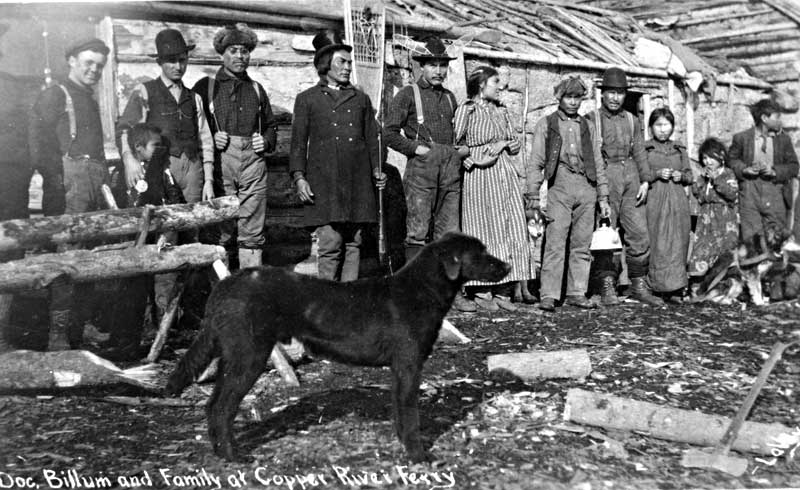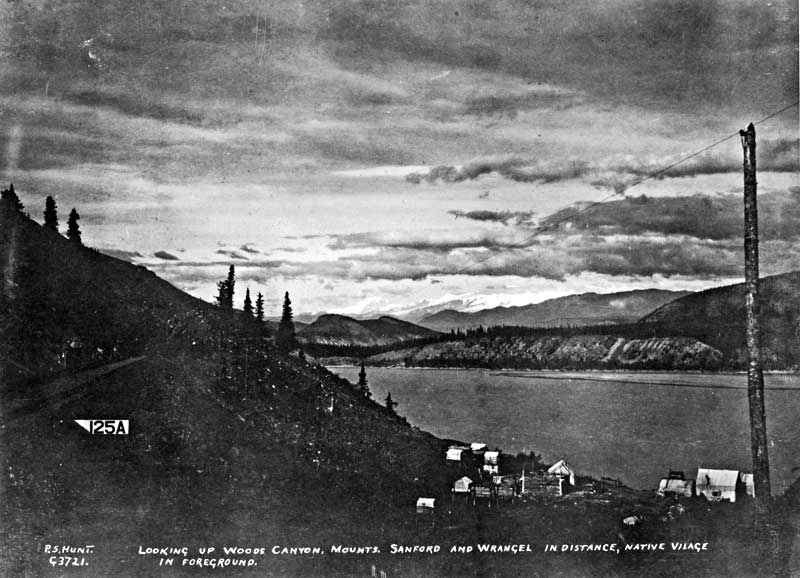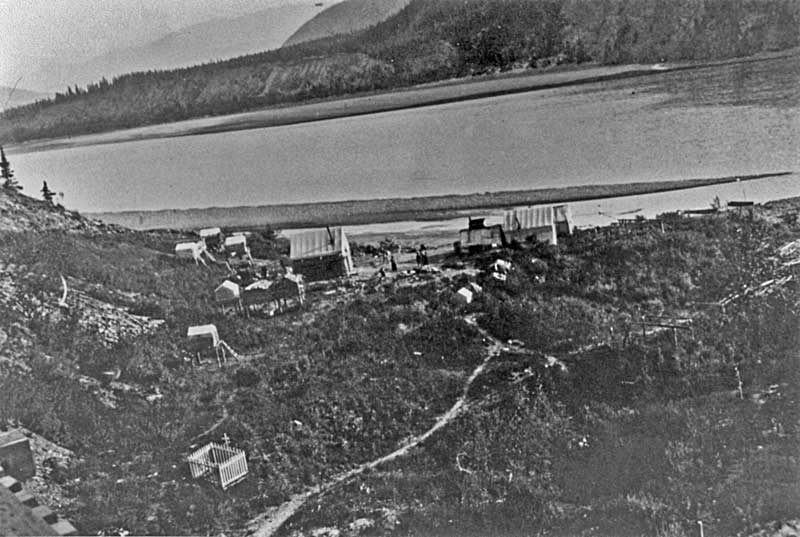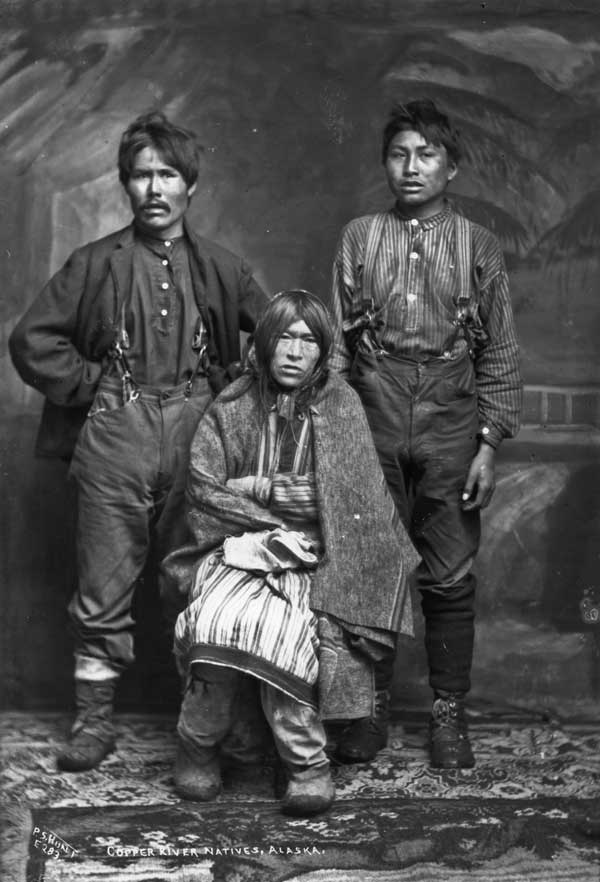Chapter 4, Pt 2: The Russian C'eyigge' ,
from "Legacy of the Chief"
from "Legacy of the Chief"
It may well have been the lure of the copper was the deciding factor in the lieutenant’s decision to alter his planned route at additional risk to his small expedition. After the party had time to recuperate, they left their cache at Taral. Skilly led Lieutenant Allen’s group through the mountainous pathway which followed the Hanagita Valley, heading east toward the high glacier country along a difficult trail which finally ended at Nicolai’s village of C’ena’Tsedi.
When he finally arrived at Nicolai’s winter camp near the Chitistone River, the lieutenant, who was a relatively young man himself, must have been quite startled to realize that the tyone was only eighteen years old. Nicolai was enormously relieved when he saw that he was facing a representative of the U.S. Army rather than of the Russian imperial navy--a party Nicolai would have been obliged to kill on the spot.
Lieutenant Allen, acting on instructions to determine whether peace could be made with the interior Indians, soon realized that he chose correctly by following Skilly to this remote place. The lieutenant soon had little doubt in his mind that Nicolai was the man who spoke for the people of the Copper River valley--’Atna’tuuTs’itu’.
Nicolai was determined to maintain the upper hand. For several hours he pretended to be unable to understand the lieutenant. Yet he understood English reasonably well, thanks to the presence of prospector John Bremner, who had stayed at Taral several months in the last year.
The lieutenant was in an unusually unique position because he had some familiarity with the Apache language. He was the first white man to recognize that the Apache and Athabascan languages were related.
He was anxious to make an accommodation with the chief, having been instructed to try to pave the way toward peaceful relations between the Native leaders and the U.S. Army. Lieutenant Allen had an earnest quality which Nicolai soon recognized. The tyone ultimately accepted his sincerity. At the same time, Nicolai was acutely aware that the lieutenant could only be the point man for some vast unknown and possibly deadly power.
 |
| from "An Expedition to the Copper, Tanana and Koyukuk River in 1885, Lt. Henry Allen |
Skilly witnessed the event. He believed that the lieutenant was suitably impressed by our young chief. Lieutenant Allen drew a simple sketch of the chief and some of his women and children at the camp. The drawing has survived to this day and is well known. Upon seeing this drawing, the chief was impressed and flattered. He finally began to talk with Lieutenant Allen in the English language.
The lieutenant wanted three things. He needed a fresh supply of food so he could return to his own cache at Taral. His provisions had already run low. Beyond that he wanted access to additional provisions for the longer trip up the Copper River. Nicolai had already greeted the party in the traditional way as honored guests. They held a great feast which demonstrated the chief’s recognition of Lieutenant Allen as an official representative of high standing. The Lieutenant found that he was treated far better than he had reason to expect.
The second request was that the chief personally accompany the lieutenant’s party up the Copper River. Nicolai was reluctant to return with Lieutenant Allen to Taral only to guide the party up the Copper River. At first he would not agree, but he contemplated the possibilities for trade and the implications of a U.S. Army official expedition entering his territory. Ultimately he recognized that it was the role the tyone of Taral to guide the party through his country. He did not agree to go beyond Taral, however, until after the party had already returned to that encampment.
His presence proved to be crucial to the expedition. It guaranteed that the party would be able to proceed through the valley in peace and with a good supply of food. Everywhere they went there was a welcoming feast honoring the tyone and his personal guests. Although Nicolai only guided the expedition as far as Tazlina, the Indians far up river, particularly the war-like Mendaesde, understood that Lieutenant Allen was to be recognized as the honored guest of the chief.
With successive chiefs at each village, Lieutenant Allen had to negotiate for provisions, using what he brought from the coast for trading stock. Fortunately the expedition still had the full cache it had left at Taral. Their supplies included tea, tobacco and other highly valued items the lieutenant would need to trade with the various chiefs. None of the village leaders would deal with the lieutenant without first consulting Nicolai. The tyone ensured that the party paid dearly for their supply of food and his continued support in the Copper River valley. Undoubtedly Lieutenant Allen was relieved when Nicolai finally turned back at Tazlina. He felt as though he had been taken by a very cunning young chief. It had been an expensive trip.
Most important and far-reaching of his three requests was the last one. Lieutenant Allen wanted the chief to reveal or at least confirm that there really was a rich source of the legendary copper. Although Nicolai refused to show the U.S. Army party the location of his tsedi, Nicolai confirmed that native copper existed everywhere. The presence of copper at the camp was readily apparent anyway, mainly due to the large number of copper gun shells. The lieutenant also saw several pieces of copper which could only have been taken from a rich vein. When he asked Nicolai to point out the direction of the richest of the tsedi, the tyone turned toward the northwest, to the ridges which extend from K’als’i Tl’aadi. He pointed in the direction of the Nicolai Prospect.
Skilly related to us that the small group of white men in the party turned silent. The tyone said nothing. He simply pointed. But there was something in the manner in which he did this which gave the party the impression that they had just learned of a sacred place. The lieutenant, the sergeant, the private and the prospector all sat in stunned silence after Nicolai waved his arm toward the mountain ridge. Until then, the only known copper existed in the occasional nuggets which were revealed by the many small streams in the area. The tyone had just pointed in the direction of the true mother lode which all white men sought. They were certain of it. Every one of them sensed the historic impact of the moment.
It was the beginning of the end for the old Ahtna ways. The white man finally had something resembling official confirmation that the legendary copper lode really existed in the Wrangells. It was only a matter of finding a way to the source and a means to transport it to the coast. That would come soon enough.
The men had many things to discuss. Grandfather asked the lieutenant about the Russians. This was when the lieutenant assured Nicolai that the dreaded and hated Russians were long gone, never to return. The lieutenant inquired about the massacres, but Nicolai had very little to say. He did not want to discuss the matter. Better to keep silent about it.
When Lieutenant Allen mistakenly said that the American government had purchased Alaska from the Russians, he received a long, thoughtful stare from the chief. Nicolai, after an uncomfortable silence, finally asked how the Russians could sell this land when the Russians themselves had never successfully laid claim to it. Indeed the Mendaesde slaughtered the Russians at Batzulnetas close to the headwaters of the Copper River many years before. The Russians never returned. They had no claim.
The tyone wanted to know how any man could believe he might own land in the same way that he owned his weapons or his clothes--or his wives. Men would be born and then they would die, but the land would always be there. The lieutenant never attempted to explain the western concept of land ownership and the chief did not want to hear it.
Nicolai then told Henry Allen that he considered the lieutenant and his party to be guests of his Ahtna hosts, in a land which had always been and always would be that of the ‘Atna’tuuTs’itu’. No other men had been known to live in this remote, rugged, mountainous country in the extreme north end of North America. Nicolai did not mention that we had ancient tales of other men who had been here at the time of the Atna’ Ben --an enormous lake said to have once covered all but the highest points of land which were themselves covered by glaciers.
The tyone was aware of the recent history of the U.S. Cavalry regarding the harsh treatment of the native inhabitants of the western United States. He was already coming to realize that everything he was trying to achieve was in danger of being ultimately lost. If nothing else, he wanted to buy as much time as possible for his people to adjust to a very different future. Their continued existence as Ahtnas had to be assured. At some point into the conversation it had dawned on Nicolai that the world of his ancestors would probably be buried with him.
Nicolai’s deep concerns not lost on Lieutenant Allen. He politely listened to the chief and thoughtfully considered what he had said. He reassured his host that he was not the lead man in a massive military invasion. The Army did not have the resources to accomplish that, in any case. The lieutenant failed to add that instead the incursion would come gradually. At first, nothing would happen at all.
Neither man held any illusions. They were acutely aware that they had just become significant pawns in an enormous twist of history. Neither wanted to dishonor the other, for there was nothing to be gained. Both made the best of what each man suspected to be the inevitable. The lieutenant now held the door open with the foot of the American government. In time the railroad would come and the door would be opened wide. The Indians saved the cavalry only to be sideswiped by the coming freight train.
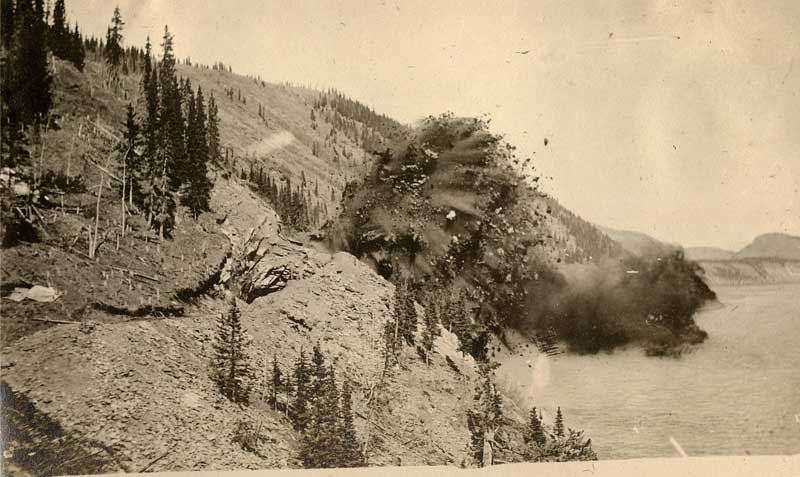 |
| The Indians saved the cavalry only to be sideswiped by the coming freight train. |
| Blasting the railbed in Woods Canyon - 1910 --John R. Van Cleve Collection |
Copper River Natives, including Horse Creek Mary, Anchorage Museum of History & Art, B62.1A.138 |
